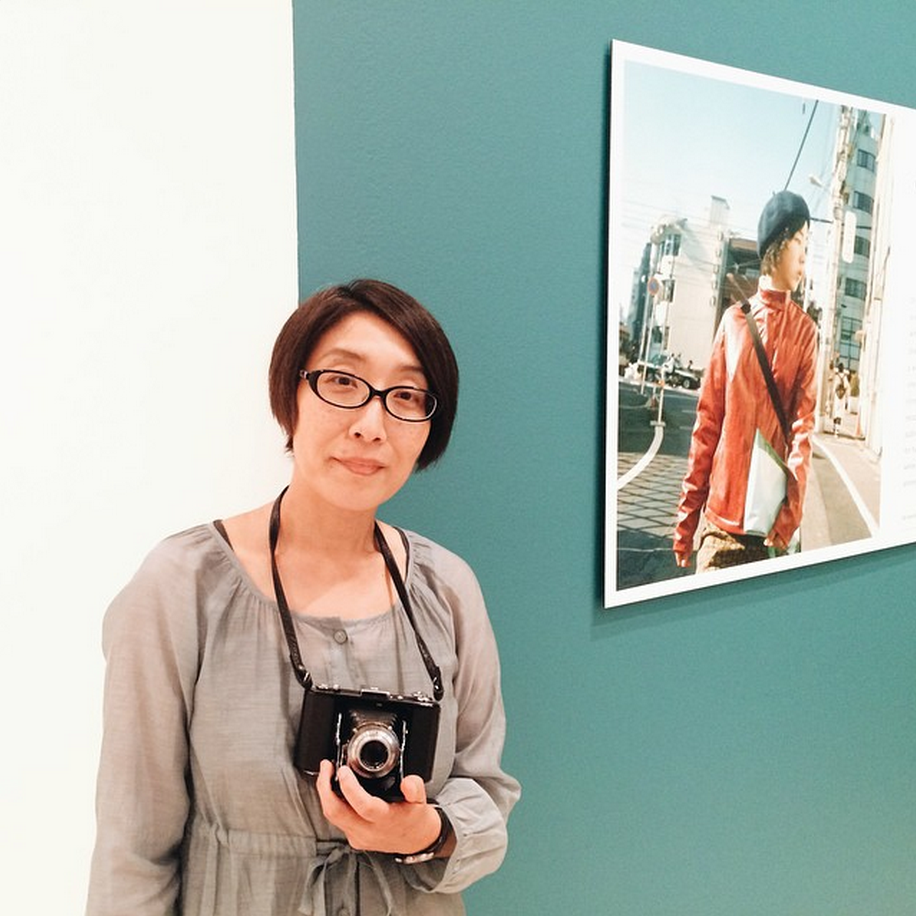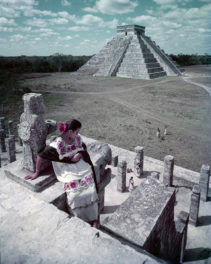
Mikiko with her camera in front of one of her photographs in In Focus: Tokyo. On wall: Untitled (Primary Speaking), 1999 (print, about 2007), Mikiko Hara. The J. Paul Getty Museum, Purchased with funds provided by the Getty Museum Photographs Council. Artwork © Mikiko Hara
Mikiko Hara is known for her snapshot-style portraits of young women in Japan. When we heard she’d be visiting L.A., we put out a call for questions via the hashtag #AskMikiko. I met with her at Giant Robot 2 just before she spoke there and signed copies of her new book These Are Days. Thanks to all who contributed the great questions!
What is your favorite type of photography?
Garry Winogrand is one of my favorite photographers. I like him because I view his photographs as being very physical. Not too composed or thought out. He doesn’t photograph with his mind, but with impulse.
What process do you use to make gallery-size color prints?
I start out printing in my darkroom at home on a standard 11 x 14″ paper. I take this print to the lab as a sample for color matching. I never use inkjet prints.
@thegetty What process do you use to make gallery size color prints? #AskMikiko
— Brian Stacy (@bugbugbug999) October 9, 2014
What sort of film do you use? Do you shoot film exclusively?
Yes, there’s so little film available to purchase these days though. I use Kodak Portra 400.
How does using film affect your creative process?
With digital photography, you can shoot and see the result right away. If at first you don’t like it, you can delete it instantly. But with film, it takes you time to wait, develop, and print these images. During this time, something could change in your feelings toward an image. When you spend time with an image, you form a relationship with it. You might end up loving an image you had a tumultuous relationship with at the start.
What was your first foray into photography?
I went to study photography at the Tokyo College of Photography after I received a literature degree at Keio University. I then continued as a research associate at Tokyo College of Photography for two years after this degree.

Question captured from The Getty tumblr.
What is your motivation to keep shooting?
Motivation in terms of passion is a bit irrelevant to me. I’ve thought about quitting many, many, many, many times. But this has become a part of my life. I always carry my camera with me wherever I go. I’m ready to shoot at all times. If I don’t have my camera with me, I become very unstable and worrisome—I cannot stop making photographs.
What was the hardest thing to photograph?
There aren’t really difficult pictures for me to take, because I don’t have an aim when I’m shooting. It’s very casual. Sure, I imagine sometimes that a photo I take will be perfect, but once developed it’s nothing. And the reverse: sometimes a thing I shoot on the fly turns out to be a masterpiece. This to me isn’t a disappointment, more like a surprise.
Do you notice that subjects respond differently to your camera now that cellphone photography has normalized photo-taking in public?
I sense that people are more aware of having their picture taken than before. As for my purposes, nobody has ever come up to me angry or confused. But I also think that my camera has a softer relationship to the subject than a camera phone’s does. Also, it helps that I have a vintage model, so most people don’t even know what I’m holding!
Does your undergraduate degree in literature impact your photography?
I must admit I was not a very serious student. I was more involved in our underground theater group as an actress. I think theatrical experience is very related to my body, and in this sense related to the physical aspect of street photography.
Do stories in Japan unfold differently then they do in the States? And if so, in what ways? What have you noticed about Los Angeles since being here?
The atmosphere is different here. It’s brighter and the air is fresher and drier. I’ve noticed there are so many cars here. It’s like cars are people’s feet. In Tokyo, it’s common to use the trains and subways as intersections. Stations become easy ways to blend in and out of new streams of merging crowds. It’s easy to take photographs in this atmosphere, but in Los Angeles there isn’t that protection. I don’t know how this will affect my photography, I will soon find out once I develop the images back home. You’ll have to hear from me later.
Special thanks to Kio Griffith (above right), who translated our conversation at Giant Robot.
Text of this post © J. Paul Getty Trust. All rights reserved.




I’m a Wedding Photographer and Events in Sao Paulo – Brazil
I really liked this Photographer, who knew her and I identified with her work a lot. LOVED IT.
Thanks for sharing.